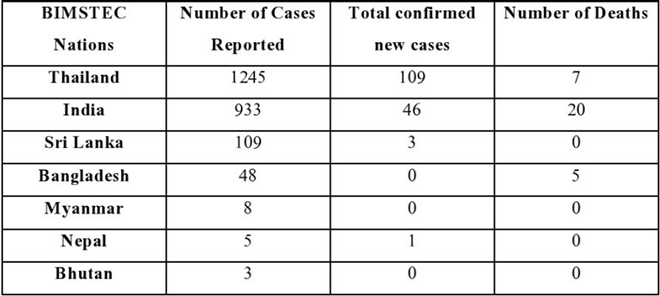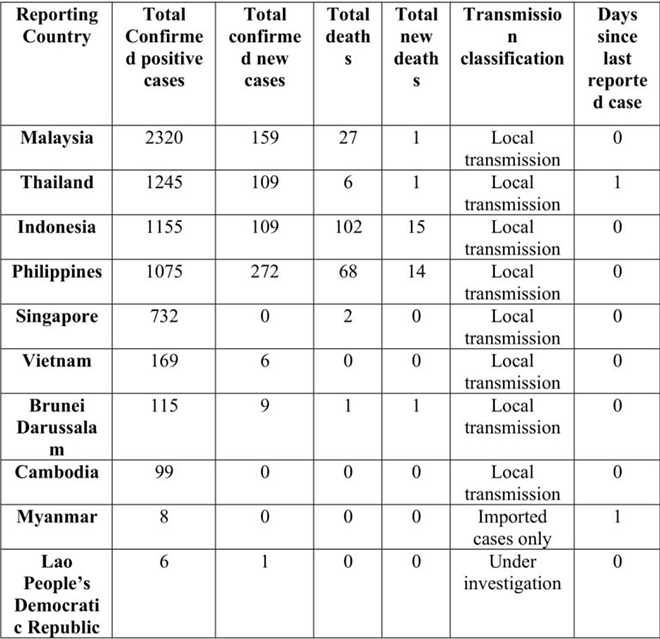-
CENTRES
Progammes & Centres
Location
ASEAN presents a very bright instance of how to deal with the situation that holds within itself the potential of being a great example for BIMSTEC.

The Coronavirus disease or the COVID19 has engulfed the world like a storm, revealing the flip side of globalisation. It has brought to the fore the widespread reach of the deadly virus which has claimed, as, on 28 March, around 28,229 lives globally and the number is exponentially on a rise. It is challenging the preparedness of each developed or developing nations to contain the said disease in terms of its health infrastructure and capacity.
The South and Southeast Asian regions have recorded 3,328 confirmed cases with 131 deaths as of 27 March. Consequently, the huge scale of the outbreak has brought about the regional forums to act closely. The three most important regional organisations in this area — the Bay of Bengal Initiative for Multi-Sectoral Technical and Economic Cooperation (BIMSTEC), the South Asian Association for Regional Cooperation (SAARC) and the Association of Southeast Asian Nations (ASEAN) — are being looked upon by the people and the global theatre at large to take actions for not only containing the situation, but also the adoption of technical frameworks to help the people survive the economic doom that shall accompany as an aftereffect of the circumstance. However, it is noteworthy that despite the efforts visible from SAARC and ASEAN, reflected through the recent video conference calls on 13 March (ASEAN) and 15 March (SAARC) respectively, as governments across the region are scrambling to enforce social distancing guidelines — the BIMSTEC forum has remained silent.
COVID19 in BIMSTEC countries
 Source: Coronavirus disease (COVID19) situation report-66, World Health Organisation
Source: Coronavirus disease (COVID19) situation report-66, World Health OrganisationThis might be since Thailand and Myanmar are part of ASEAN which is working closely to combat the disease. However, the current situation forces one to glance through the status of BIMSTEC nations as per COVID19 cases and their preparedness to respond effectively. In fact, there is a specific sector on ‘public health’ in BIMSTEC, led by Thailand, previously reassuring the availability of medication facilities and aid to the ‘impoverished’. Given the stagnation of SAARC in the last few years, BIMSTEC would have undoubtedly been a more effective podium to generate cooperation among countries in the region, collaborating with ASEAN, as there are countries which are mutually present in both the groups.
Given that Thailand is currently the worst affected nation in the BIMSTEC region with the steadily growing number of confirmed positive cases and deaths, it could have easily led the process being the leader of the public health domain. Thailand was the first country outside China to report a case in mid-January. However, while China shut down Wuhan, the Thai authorities took several weeks after the Wuhan outbreak to stop flights to and from the Hubei capital. Differences of opinion within the ministry on COVID19 management resulted in the delay before a list of at-risk countries was finally drawn up. Yet Thailand’s two main airports in Bangkok stayed more or less open to global travellers, while quarantine precautions were vague. Even the handling of face masks became enmeshed in profiteering, apparently involving official corruption. Now, beginning from 26 March the country will be on emergency mode with border movements being strictly monitored. If the country had realised its potential and position, the aggravation could have been withheld.
ASEAN presents a very bright instance of how to deal with the situation that holds within itself the potential of being a great example for BIMSTEC. ASEAN has been extremely proactive in dealing with the COVID19. With the highest number of affected cases in Malaysia, there seems to be no end to the ever-increasing figures in the past one week, thereby resulting in the adoption of stringent steps not only from the organisation as a whole but in each country as well.
COVID19 in the ASEAN countries
 Source: Coronavirus disease (COVID19) situation report 66, World Health Organisation
Source: Coronavirus disease (COVID19) situation report 66, World Health OrganisationAlmost all the ASEAN countries are now preparing for the third stage of the infection, where the entire community gets affected. In this regard, the collective response through the ASEAN health sector has been portrayed as the best way to deal with this global ‘pandemic’. At present Cambodia is the chair for the ASEAN Health Ministers’ and ASEAN Senior Officials’ health development programs. The entire framework was reconvened on 13 March through a special video conference, for prevention and control, primarily focused on the establishment of cooperative mechanisms through dialogue and development. Additionally, all the mechanisms adopted in August 2019’s joint Statement of the 8th ASEAN Plus Three Health Ministers Meeting and the pledge to “continue efforts in the implementation of the International Health Regulation (IHR) and Asia Pacific Strategy for Emerging Diseases to enhance capacities to prevent, detect and respond to public health threats” was refurbished back again. In this hour of crisis, the existing counterparts of this framework in China, Japan and Korea have also decided to share timely information and other overarching data, including updates on the COVID19 scenario. The ASEAN Emergency Operations Centre (EOC) Network for public health emergencies (ASEAN EOC Network) and the ASEAN BioDiaspora — must be mentioned here as one of the major stepping stones in combating the virus, making the outreach capacity easier. A special dedicated file has been uploaded and also being constantly updated that even mentions the flights from the neighbouring ASEAN countries from where there might be any potential threat in the future. The centres led by Malaysia and the Philippines respectively have been working relentlessly to provide technical support as well as maintaining a dedicated webpage for the response mechanism.
Similarly, from an economic perspective, 10 March noted the Twenty Sixth ASEAN Economic Ministers’ Retreat, specifically addressing the COVID19. Apart from the expression of solidarity, the meeting brought forth several points of agreement like maintaining the prohibition of any unnecessary ‘inflationary pressures’ negative impact on the food security of the region or the promotion of ‘supply chain connectivity’ and the smooth flow of goods and services to mention three were put forward.
In lieu of the fact that the region is very close to China, the lurking threat is increasing day by day. Not only emanating from potential risks of travel, either within the region or from China for that matter, the financial impact that would stem later on has been a severe concern. China has been ASEAN’s second-largest trading partner with more than USD 500 billion earned in 2019. However, what would come off this situation only time would be able to tell. Nonetheless, to tackle this issue, industries like tourism, hospitality and aviation have been given opportunities like non-fiscal and fiscal incentives along with tax breaks for the citizens later in the year.
This is where the proactiveness of the BIMSTEC has been faced with a major challenge. Whereas it could easily facilitate its website — bimstec.org — as an important medium for the transfer and exchange of important news and precautionary measures for the global pandemic, nothing at all has been visible. Although India is undoubtedly acting as a driving force in SAARC where countries like Nepal and Bhutan are also receiving the required assistance, the need of the hour is to make use of the best possible and the most active platforms for the dissemination of medical facilitation and awareness generation. Though each nation has stepped up their vigilance and health care facilities to ensure beds and necessary care for positive patients along with various stimulus packages for its citizens however effective surveillance is required. The increase of diagnostic labs and kits is essential to ensure proper detection and is currently a gap area. The numbers in the BIMSTEC region in comparison to the worldwide trend is hinting on the fact that far fewer people are being tested for the disease. The SAARC COVID19 fund is currently being operated through Delhi and not under the regional domain and thus it may be used by other neighbour states if required. JIPMER- BIMSTEC Telemedicine Network (JBTN) designed to strengthen links among premier medical institutions in the region may be utilised to research innovative medicines and knowledge sharing to fight this virus. It is important that BIMSTEC realises its own expertise in creating a better zone of convergence, which will also be very helpful in the long run to strengthen its foot as a better organisation of worth.
This commentary originally appeared in The Diplomat.
The views expressed above belong to the author(s). ORF research and analyses now available on Telegram! Click here to access our curated content — blogs, longforms and interviews.

Sreeparna Banerjee is an Associate Fellow in the Strategic Studies Programme. Her work focuses on the geopolitical and strategic affairs concerning two Southeast Asian countries, namely ...
Read More +
Sohini Nayak was a Junior Fellow at Observer Research Foundation. Presently she is working on Nepal-India and Bhutan-India bilateral relations along with sub regionalism and ...
Read More +